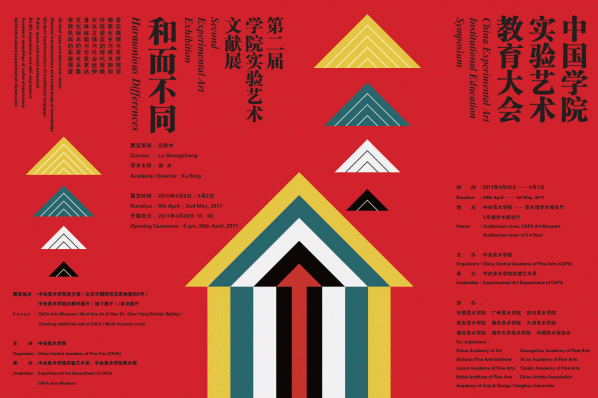Harmonious Differences – Second Experimental Art Exhibition will be held at the Central Academy of Fine Arts from April 8th, 2011 through May 2nd, 2011. An opening ceremony of the China Experimental Art Institutional Education Symposium will be held on April 28th, 2011. The exhibition will showcase China’s fine art institutes’ achievements in experimental art teaching, research and creation. It will demonstrate how China’s fine art education today is now opening to more diverse academic ways of thinking.

Poster of China Experimental Art Institutional Education Symposium
As schools have always been where human intelligence and creativity are developed, China’s fine art education and the talents it has discovered and trained have played an important role in modern and contemporary art. With China’s political, economic and cultural reforms and parallel global cultural dialogues, China’s contemporary experimental art has entered the global arena and receives increasing attention. At the same time, art education has been making adjustments and improvements. To establish a balance between the westernized art theories applied in the last century and Chinese traditional art and culture, China’s contemporary art is expected to undergo a formal and qualitative transformation. Fine art institutes shall take on more comprehensive and macro responsibilities in the future development of culture and the arts.
Mainstream fine art education has long been based on Western painting practices and the realist style. During the past decade, however, the concept of “experimental art” has gradually emerged and increased in popularity among fine art institutes and has became a dynamic academic concentration. If the 1980s avant-garde artists were able to break through institutional boundaries in order to become the elite of today, those interested in engaging in experimental art today shall study the relevant systematic methods and practices showcased at this exhibition, develop comprehensive qualities through institutionalized academic and theoretical education, and become the cutting edge artistic force in the international arena.
The exhibition is divided into seven parts:
- Normal eyes and abnormal vision
- Material transformation and technological knowledge
- Modern transformation of traditional language
- Public space and social extension
- Bodily experience and self-expression
- Academic samplings of cultural specimens
- Institutionalized experimental classrooms
The first six parts present paintings, sculptures, installations, videos, performances and texts created by students of various Chinese fine art institutes during the past six years. They illustrate how experimental art has blossomed through institutionalized education in China. The exhibition will become a significant milestone in China’s contemporary art history.
The last part, “Institutionalized experimental classrooms,” will select 12 outstanding experimental art curriculum and teaching programs from among various fine art institutes as case studies. It will not only provide teaching agendas and notes for instructors, but also showcase the overall outlook of student works created during a single course or for other art projects. Each case will be equivalent to a themed group show, linked only by the fact that this exhibition is based on the academic theme and theoretical guidance of experimental art education.
View the Chinese version of this article here




























